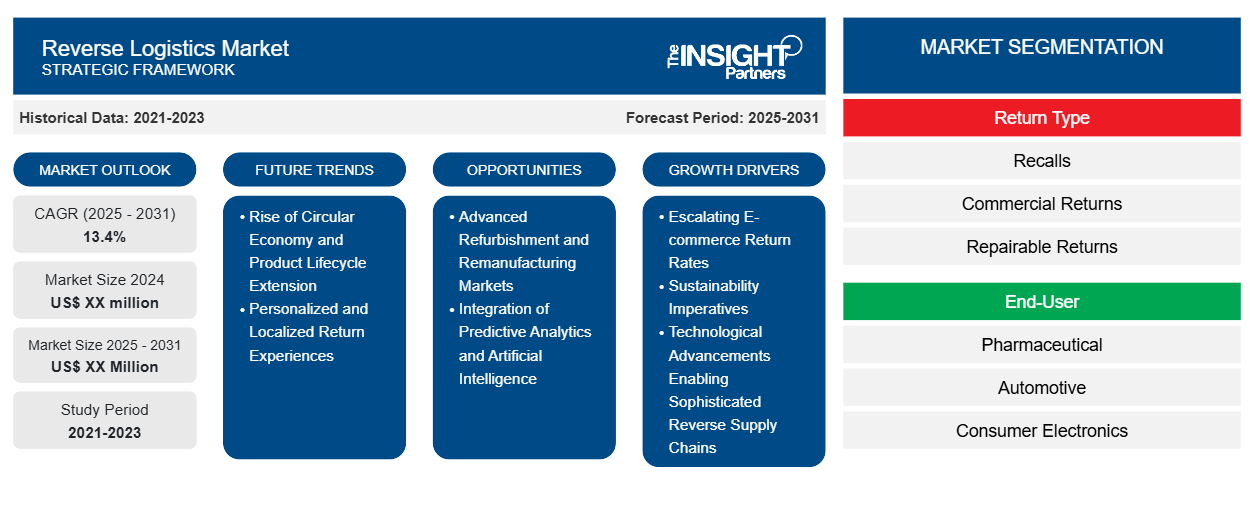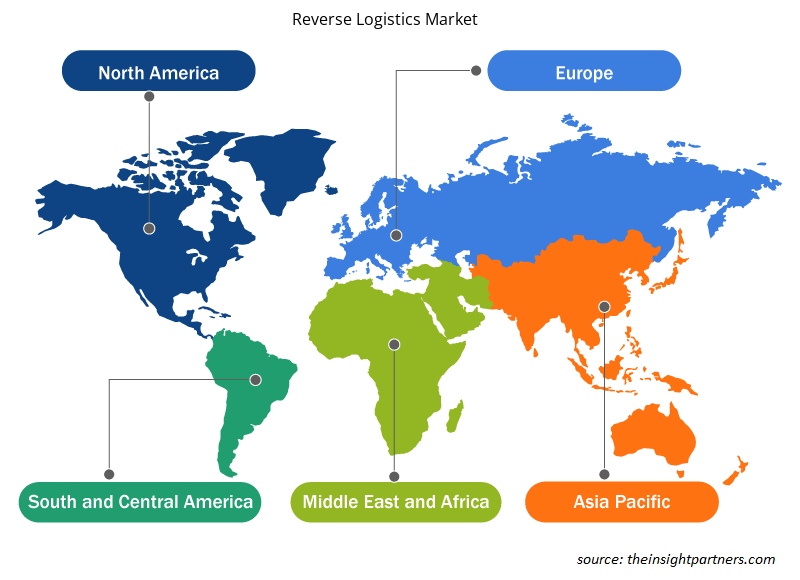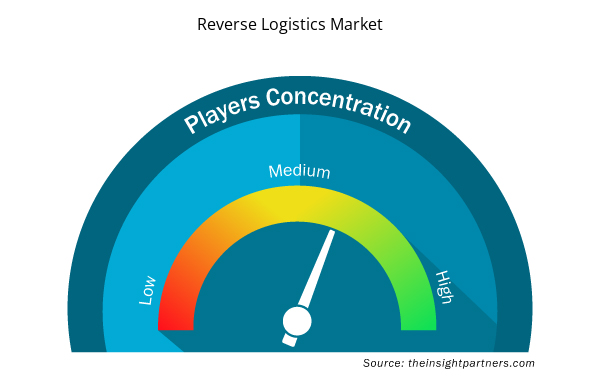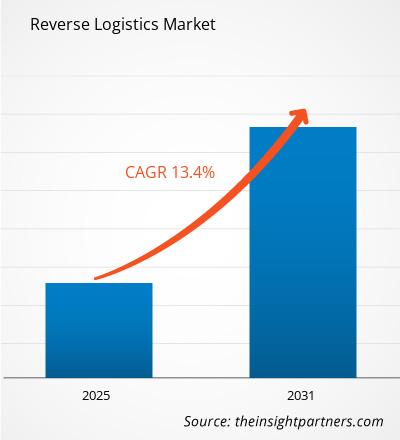The Reverse Logistics Market is expected to register a CAGR of 13.4% from 2025 to 2031, with a market size expanding from US$ XX million in 2024 to US$ XX Million by 2031.
The report is segmented by Return Type (Recalls, Commercial Returns, Repairable Returns, End-of-Use Returns, End-of Life Returns); End-User (Pharmaceutical, Automotive, Consumer Electronics, Retail, Others). The global analysis is further broken-down at regional level and major countries. The Report Offers the Value in USD for the above analysis and segments.
Purpose of the Report
The report Reverse Logistics Market by The Insight Partners aims to describe the present landscape and future growth, top driving factors, challenges, and opportunities. This will provide insights to various business stakeholders, such as:
- Technology Providers/Manufacturers: To understand the evolving market dynamics and know the potential growth opportunities, enabling them to make informed strategic decisions.
- Investors: To conduct a comprehensive trend analysis regarding the market growth rate, market financial projections, and opportunities that exist across the value chain.
- Regulatory bodies: To regulate policies and police activities in the market with the aim of minimizing abuse, preserving investor trust and confidence, and upholding the integrity and stability of the market.
Reverse Logistics Market Segmentation
Return Type
- Recalls
- Commercial Returns
- Repairable Returns
- End-of-Use Returns
- End-of Life Returns
End-User
- Pharmaceutical
- Automotive
- Consumer Electronics
- Retail
- Others
Customize This Report To Suit Your Requirement
You will get customization on any report - free of charge - including parts of this report, or country-level analysis, Excel Data pack, as well as avail great offers and discounts for start-ups & universities
Reverse Logistics Market: Strategic Insights

- Get Top Key Market Trends of this report.This FREE sample will include data analysis, ranging from market trends to estimates and forecasts.
Reverse Logistics Market Growth Drivers
- Escalating E-commerce Return Rates: The exponential growth of online shopping has significantly increased product return volumes. Consumers now expect seamless, hassle-free return policies, pushing companies to develop sophisticated reverse logistics infrastructure. With return rates ranging from 20-30% in e-commerce, compared to 8-10% in traditional retail, businesses are compelled to invest in efficient return management systems. This trend necessitates advanced tracking technologies, robust reverse supply chain processes, and strategic asset recovery mechanisms to minimize financial losses and enhance customer satisfaction.
- Sustainability Imperatives: Environmental concerns and circular economy principles are driving substantial investments in reverse logistics. Companies are recognizing the economic and ecological benefits of product recycling, refurbishment, and responsible disposal. Regulatory pressures, particularly in electronics and packaging sectors, mandate comprehensive waste management strategies. Organizations are developing comprehensive reverse logistics frameworks that not only reduce environmental impact but also create value through material recovery, remanufacturing, and secondary markets, transforming what was previously considered waste into potential revenue streams.
- Technological Advancements Enabling Sophisticated Reverse Supply Chains: Emerging technologies like artificial intelligence, blockchain, and advanced analytics are revolutionizing reverse logistics capabilities. These innovations enable real-time tracking, predictive maintenance, and intelligent routing of returned products. Machine learning algorithms help businesses predict return probabilities, optimize refurbishment processes, and make data-driven decisions about product disposition. IoT sensors and digital platforms provide unprecedented visibility into return flows, allowing companies to streamline operations, reduce processing times, and extract maximum value from returned merchandise.
Reverse Logistics Market Future Trends
- Rise of Circular Economy and Product Lifecycle Extension: The circular economy concept is transforming reverse logistics from a cost center to a strategic value creation mechanism. Companies are designing products with recyclability and easy disassembly in mind, enabling more efficient material recovery. Innovative business models like product-as-a-service are emerging, where manufacturers retain ownership and responsibility for product lifecycles. This trend encourages more sustainable consumption patterns, reduces waste, and creates new revenue opportunities through refurbishment, remanufacturing, and material reclamation strategies.
- Personalized and Localized Return Experiences: Consumer expectations are driving a shift towards more flexible, convenient return experiences. Retailers are implementing hyper-local return strategies, including in-store drop-offs, curbside returns, and partnerships with third-party logistics providers. AI-powered personalization helps businesses tailor return policies based on individual customer behavior, product characteristics, and historical return patterns. These localized approaches reduce transportation costs, minimize environmental impact, and enhance overall customer satisfaction by providing more convenient and personalized return processes.
Reverse Logistics Market Opportunities
- Advanced Refurbishment and Remanufacturing Markets: The growing market for certified pre-owned and refurbished products presents significant opportunities across multiple sectors. Electronics, automotive, and industrial equipment industries are developing sophisticated refurbishment processes that restore products to near-original condition. These markets offer lower-cost alternatives to new products while reducing environmental waste. Specialized reverse logistics providers can develop expertise in product assessment, repair, and remarketing, creating lucrative business models that bridge sustainability goals with profitable secondary markets.
- Integration of Predictive Analytics and Artificial Intelligence: Sophisticated data analytics and AI technologies offer unprecedented opportunities for optimizing reverse logistics operations. Predictive models can forecast return probabilities, identify potential product issues before they occur, and recommend optimal disposition strategies. Machine learning algorithms can analyze return patterns, helping businesses redesign products, improve quality control, and develop more effective return policies. These technologies enable more precise inventory management, reduce processing costs, and transform reverse logistics from a reactive to a proactive business function.
Reverse Logistics Market Regional Insights
The regional trends and factors influencing the Reverse Logistics Market throughout the forecast period have been thoroughly explained by the analysts at Insight Partners. This section also discusses Reverse Logistics Market segments and geography across North America, Europe, Asia Pacific, Middle East and Africa, and South and Central America.

- Get the Regional Specific Data for Reverse Logistics Market
Reverse Logistics Market Report Scope
| Report Attribute | Details |
|---|---|
| Market size in 2024 | US$ XX million |
| Market Size by 2031 | US$ XX Million |
| Global CAGR (2025 - 2031) | 13.4% |
| Historical Data | 2021-2023 |
| Forecast period | 2025-2031 |
| Segments Covered |
By Return Type
|
| Regions and Countries Covered | North America
|
| Market leaders and key company profiles |
Reverse Logistics Market Players Density: Understanding Its Impact on Business Dynamics
The Reverse Logistics Market market is growing rapidly, driven by increasing end-user demand due to factors such as evolving consumer preferences, technological advancements, and greater awareness of the product's benefits. As demand rises, businesses are expanding their offerings, innovating to meet consumer needs, and capitalizing on emerging trends, which further fuels market growth.
Market players density refers to the distribution of firms or companies operating within a particular market or industry. It indicates how many competitors (market players) are present in a given market space relative to its size or total market value.
Major Companies operating in the Reverse Logistics Market are:
- C.H. Robinson Worldwide, Inc.
- Core Logistic Private Limited
- DB SCHENKER
- DHL International GmbH
- FedEx Corporation
Disclaimer: The companies listed above are not ranked in any particular order.

- Get the Reverse Logistics Market top key players overview
Key Selling Points
- Comprehensive Coverage: The report comprehensively covers the analysis of products, services, types, and end users of the Reverse Logistics Market, providing a holistic landscape.
- Expert Analysis: The report is compiled based on the in-depth understanding of industry experts and analysts.
- Up-to-date Information: The report assures business relevance due to its coverage of recent information and data trends.
- Customization Options: This report can be customized to cater to specific client requirements and suit the business strategies aptly.
The research report on the Reverse Logistics Market can, therefore, help spearhead the trail of decoding and understanding the industry scenario and growth prospects. Although there can be a few valid concerns, the overall benefits of this report tend to outweigh the disadvantages.
- Historical Analysis (2 Years), Base Year, Forecast (7 Years) with CAGR
- PEST and SWOT Analysis
- Market Size Value / Volume - Global, Regional, Country
- Industry and Competitive Landscape
- Excel Dataset


- Trade Promotion Management Software Market
- Data Center Cooling Market
- Diaper Packaging Machine Market
- Europe Industrial Chillers Market
- Virtual Production Market
- Broth Market
- Advanced Planning and Scheduling Software Market
- Electronic Shelf Label Market
- Water Pipeline Leak Detection System Market
- Electronic Toll Collection System Market

Report Coverage
Revenue forecast, Company Analysis, Industry landscape, Growth factors, and Trends

Segment Covered
This text is related
to segments covered.

Regional Scope
North America, Europe, Asia Pacific, Middle East & Africa, South & Central America

Country Scope
This text is related
to country scope.
Frequently Asked Questions
Some of the customization options available based on the request are an additional 3-5 company profiles and country-specific analysis of 3-5 countries of your choice. Customizations are to be requested/discussed before making final order confirmation, as our team would review the same and check the feasibility.
The report can be delivered in PDF/PPT format; we can also share excel dataset based on the request.
The leading players operating in the Reverse Logistics Market include C H Robinson Worldwide Inc, Core Logistic Private Limited, DB SCHENKER, DHL International GmbH, FedEx Corporation, Kuehne Nagel International AG, Safexpress Pvt Ltd, United Parcel Service of America Inc, and YUSEN LOGISTICS CO LTD
The Reverse Logistics Market is estimated to witness a CAGR of 13.4% from 2023 to 2031
Changing customer preference is the key future trend of the Reverse Logistics Market
The major factors driving the Reverse Logistics Market are: Advent of Advanced Technology such as Automation, Blockchain, and other
Trends and growth analysis reports related to Automotive and Transportation : READ MORE..
1. C.H. Robinson Worldwide, Inc.
2. Core Logistic Private Limited
3. DB SCHENKER
4. DHL International GmbH
5. FedEx Corporation
6. Kuehne + Nagel International AG
7. Safexpress Pvt. Ltd.
8. United Parcel Service of America, Inc
9. YUSEN LOGISTICS CO, LTD
10. Zebra Technologies Corp

 Get Free Sample For
Get Free Sample For